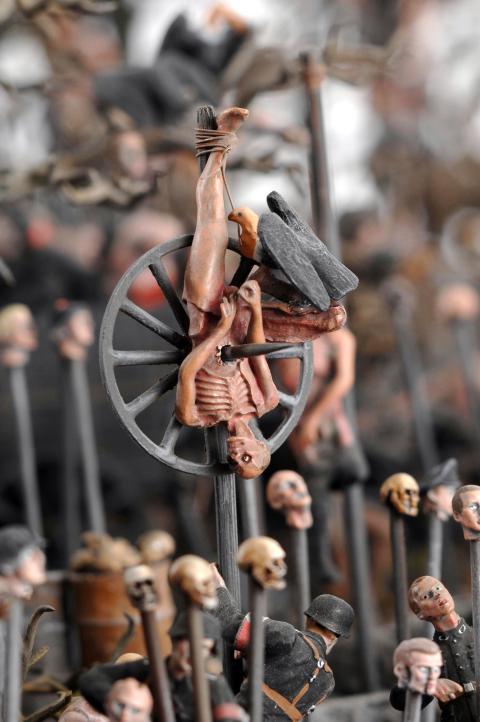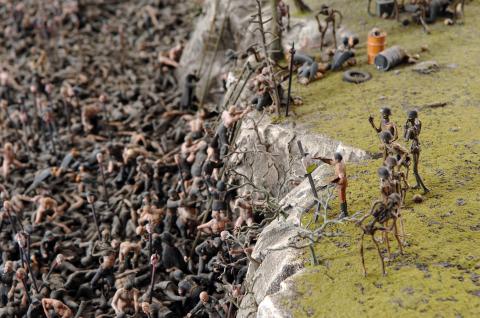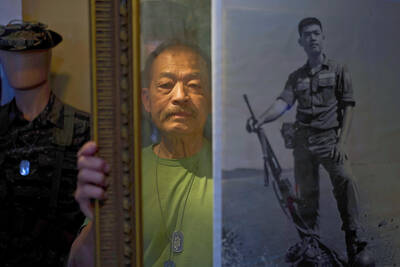Browsing the bookstore shelves can pose grim challenges for the ordinary mortal. The reproachful cover of 1,000 Places to See Before You Die is bad enough. There’s also 100 Birds to See Before You Die, 100 Belgian Beers to Try Before You Die! and 1,001 Video Games You Must Play Before You Die. Make your way through 50 Places to Play Golf Before You Die and you’re still not done: 50 More Places to Play Golf Before You Die is staring right at you.
Into this profusion of lists comes Matthew White, a self-described “atrocitologist” and numbers freak from Richmond, Virginia, who has compiled yet another — more sobering — roll call to ponder. With its stylishly lurid graphics and goofy asides, The Great Big Book of Horrible Things: The Definitive Chronicle of History’s 100 Worst Atrocities may seem more like an aspiring classic of macabre bathroom reading than a serious effort. But White’s book, published this week by W.W. Norton, arrives trailing some impressive scholarly affirmation, including a ringing foreword from the Harvard psychologist Steven Pinker.
If cold-bloodedly ranking body counts seems like an odd business, White, a bearlike man of 54 with a shy laugh and incipient Santa Claus beard, is an even odder person to be doing it.

Photo: Bloomberg
He has no college degree or formal training in history or statistics. He does not attend academic conferences or publish in scholarly journals. He does not visit archives, instead culling numbers from far-flung secondary sources during off hours from his job as a librarian at the federal courthouse in Richmond. His Web site includes links to Tolkien-inspired maps and random self-help reflections (the page for “How to Overcome Procrastination” is listed as “Under Construction”), along with links to carefully annotated compilations of war statistics. He prefers jaunty terms like multicide, megadeath and hemoclysm to sober, morally charged ones like genocide.
“I’ve always been a bit of a wiseguy,” White said, though he is quick to add that he means no offense. Atrocity is a serious business, and the numbers he puts up are staggering, from the well known (1.67 million victims of the Khmer Rouge, atrocity No. 39 on White’s list) to the largely forgotten (13 million dead from the An Lushan Rebellion in eighth-century China, which lands at No. 13).
Fifteen years ago White was just a local-history buff with a vague dream of creating a historical atlas of Richmond. But one day, for reasons he is hard pressed to explain, he drew a map illustrating the collapse of the Soviet Union and posted it on the World Wide Web, which was then new. More maps followed, and his grandly titled Historical Atlas of the 20th Century was born.

Photo: Bloomberg
The obsession with body counts came later, along with a steady accumulation of citations by recognized scholars: 377 published books and 183 scholarly articles to date. (Yes, White has the stats.)
In his foreword to The Great Big Book Pinker — who drew on White’s work for own new book, The Better Angels of Our Nature: Why Violence Has Declined — credits him with compiling “the most comprehensive, disinterested and statistically nuanced estimates available.”
Charles Maier, a historian of modern European history at Harvard who stumbled on White’s Web site five years ago when searching for reliable death counts in the two world wars, doesn’t put it that strongly but welcomes his painstaking efforts nonetheless.
“These figures are notoriously elusive,” Maier said, adding that White “seems to have tried to get the best figures he could.”
White’s methodology is simple. He gathers every estimate he can find, including some that mainstream historians might reject as unsavory. (“Beggars can’t be choosers,” he writes.) He throws out the highest and lowest numbers and then calculates the median, arriving at what he acknowledges is often just an informed guess. Deaths from famine and disease stemming from armed conflict count, but natural disasters and purely economic events do not. (“There has to be a core of violence,” he explained.) All sources are listed on his Web site, along with darkly witty ruminations on the inherent uncertainty of numbers, especially where what he calls “mass unpleasantness” is involved.
White’s estimates are “at the high end of the range,” Pinker said. But he called White’s transparency about his sources impressive and his methodology statistically sound, in keeping with the scientific tradition of meta-analysis of previous studies.
But not all scholars are so confident about White’s numbers. Benedict Kiernan, director of Yale’s Genocide Studies Program and an expert in the Khmer Rouge, said in an e-mail that averaging guesses alongside more precise counts can be misleading. (White’s Web page on the Cambodian genocide, however, “looks to be a careful compilation,” Kiernan said.)
Others say it can be difficult to make quantitative assessments of violence without a strong qualitative grasp of the context. To evaluate the reliability of a source, historians need to be immersed in that period, including its modes of exaggeration, said Randolph Roth, co-director of the Historical Violence Database at Ohio State University. While he admires White’s willingness to look at the big picture, he said, “it’s going to be hard for many historians to read this book and look at that death toll for Genghis Khan, that 40 million, and not have a sinking feeling.”
When it comes to atrocitology, White likes to say, the side of caution is usually the high side, especially where an event remains politically charged. Which isn’t to say he has much patience for Internet chestnuts like “Which has killed more people: Christianity or gun control?” He is equally skeptical of the claim that the 20th century had 174 million instances of “democide,” or death by government, an idea advanced by R.J. Rummel, a professor emeritus of political science at the University of Hawaii, and enthusiastically embraced in some corners of the libertarian blogosphere.
White, who describes his politics simply as “kind of pacifist,” said that Rummel — who keeps a Web site with its own eccentric vocabulary (“mortacracies,” “megamurderers”) and an early-Internet design sense to rival White’s own — tends to define every warlord, rogue militia and lynch mob as a form of government, rather than a sign of its lack.
The lessons of his own survey, White said, are clear. No one system of government is obviously more murderous, and anarchy can be worst of all. “Governments don’t kill people,” he said. “People kill people.”
Rummel, in an e-mail, dismissed White’s numbers as “not reliable,” adding that it matters greatly whether Stalin killed 20 million people, White’s figure, or 61 million, his own figure. “When the magnitude is so great, it is a profound statement on the nature of communism,” he said.
Such polemics may have receded in mainstream historical circles since the late 1990s, when the publication of The Black Book of Communism, which placed the global death toll of Marxist regimes at 85 million to 100 million, inspired fierce debates about the relative evils of communism and Nazism. (Mike Davis’ 2001 book, Late Victorian Holocausts, in turn, indicted capitalist imperialism for tens of millions of famine deaths in the developing world.)
White, for his part, may start arguments with his own equivalences, such as lumping the Jewish victims of the Holocaust in with the 66 million total deaths in World War II, his No. 1 most horrible thing of all time.
Still, the question of which regime or ruler is the worst, according to Maier, the Harvard historian, remains “a very natural question,” even if most historians resist dwelling too much on the numbers.
“Most of us feel ashamed about doing this kind of raw exercise,” Maier said, adding: “Here’s a guy who hasn’t been afraid to get his hands dirty.”

On April 26, The Lancet published a letter from two doctors at Taichung-based China Medical University Hospital (CMUH) warning that “Taiwan’s Health Care System is on the Brink of Collapse.” The authors said that “Years of policy inaction and mismanagement of resources have led to the National Health Insurance system operating under unsustainable conditions.” The pushback was immediate. Errors in the paper were quickly identified and publicized, to discredit the authors (the hospital apologized). CNA reported that CMUH said the letter described Taiwan in 2021 as having 62 nurses per 10,000 people, when the correct number was 78 nurses per 10,000

As we live longer, our risk of cognitive impairment is increasing. How can we delay the onset of symptoms? Do we have to give up every indulgence or can small changes make a difference? We asked neurologists for tips on how to keep our brains healthy for life. TAKE CARE OF YOUR HEALTH “All of the sensible things that apply to bodily health apply to brain health,” says Suzanne O’Sullivan, a consultant in neurology at the National Hospital for Neurology and Neurosurgery in London, and the author of The Age of Diagnosis. “When you’re 20, you can get away with absolute

When the South Vietnamese capital of Saigon fell to the North Vietnamese forces 50 years ago this week, it prompted a mass exodus of some 2 million people — hundreds of thousands fleeing perilously on small boats across open water to escape the communist regime. Many ultimately settled in Southern California’s Orange County in an area now known as “Little Saigon,” not far from Marine Corps Base Camp Pendleton, where the first refugees were airlifted upon reaching the US. The diaspora now also has significant populations in Virginia, Texas and Washington state, as well as in countries including France and Australia.

May 5 to May 11 What started out as friction between Taiwanese students at Taichung First High School and a Japanese head cook escalated dramatically over the first two weeks of May 1927. It began on April 30 when the cook’s wife knew that lotus starch used in that night’s dinner had rat feces in it, but failed to inform staff until the meal was already prepared. The students believed that her silence was intentional, and filed a complaint. The school’s Japanese administrators sided with the cook’s family, dismissing the students as troublemakers and clamping down on their freedoms — with